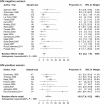Vertical transmission of hepatitis C virus: systematic review and meta-analysis
- PMID: 24928290
- PMCID: PMC4144266
- DOI: 10.1093/cid/ciu447
Vertical transmission of hepatitis C virus: systematic review and meta-analysis
Abstract
Background: We conducted a systematic review of estimates of hepatitis C virus (HCV) vertical transmission risk to update current estimates published more than a decade ago.
Methods: PubMed and Embase were searched and 109 articles were included. Pooled estimates of risk were generated for children born to HCV antibody-positive and viremic women, aged ≥18 months, separately by maternal human immunodeficiency virus (HIV) coinfection.
Results: Meta-analysis of the risk of vertical HCV infection to children of HCV antibody-positive and RNA-positive women was 5.8% (95% confidence interval [CI], 4.2%-7.8%) for children of HIV-negative women and 10.8% (95% CI, 7.6%-15.2%) for children of HIV-positive women. The adjusted meta-regression model explained 51% of the between-study variation in the 25 included risk estimates. Maternal HIV coinfection was the most important determinant of vertical transmission risk (adjusted odds ratio, 2.56 [95% CI, 1.50-4.43]). Additional methodological (follow-up rate and definition of infection in children) and risk factors independently predicted HCV infection and need to be captured and reported by future studies of vertical transmission. Studies assessing the contribution of nonvertical exposures in early childhood to HCV prevalence among children at risk of vertical transmission are needed.
Conclusions: More than 1 in every 20 children delivered by HCV chronically infected women are infected, highlighting that vertical transmission likely constitutes the primary transmission route among children. These updated estimates are a basis for decision making in prioritization of research into risk-reducing measures, and inform case management in clinical settings, especially for HIV-positive women in reproductive age.
Keywords: infant; infectious disease transmission; mother-to-child transmission; pregnancy; risk factors.
© The Author 2014. Published by Oxford University Press on behalf of the Infectious Diseases Society of America.
Figures



References
-
- Mohd Hanafiah K, Groeger J, Flaxman AD, Wiersma ST. Global epidemiology of hepatitis C virus infection: new estimates of age-specific antibody to HCV seroprevalence. Hepatology. 2013;57:1333–42. - PubMed
-
- Roberts EA, Yeung L. Maternal-infant transmission of hepatitis C virus infection. Hepatology. 2002;36(5 suppl 1):S106–13. - PubMed
-
- Castro Sanchez AY, Aerts M, Shkedy Z, et al. A mathematical model for HIV and hepatitis C co-infection and its assessment from a statistical perspective. Epidemics. 2013;5:56–66. - PubMed
Publication types
MeSH terms
LinkOut - more resources
Full Text Sources
Other Literature Sources
Medical

